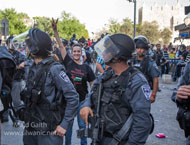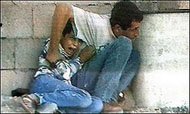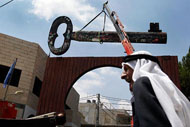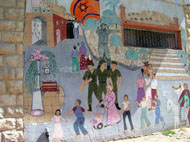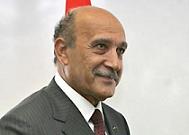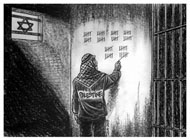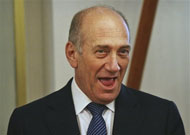After four months of anticipation, intrigue and debate concerning Annapolis and its agenda, the summit at the home of the US Naval Academy has now come to a close. Just like all events that have a tendency to incite a glimmer of hope and are thus eagerly awaited, it flew past in the blink of an eye and made the most minimal impact possible on the Palestinian / Israeli situation.
In their meetings preceding Annapolis, the Palestinian and Israeli negotiating teams failed to present to US President Bush a joint document/statement on which they both agreed [previously this accord had been viewed as the prerequisite for the summit]. Coincidently however, with no agreement made on Monday night, President Bush read out a joint document signed by both Israeli Prime Minister Ehud Olmert and President Mahmoud Abbas half an hour before the meeting convened.
What was in this document? The answer is very little. President Bush, before jetting off on his helicopter, spoke about Annapolis being “the beginning of the process, not the end of it”, sporting his traditional smile of content which accompanied the words he delivered. The document, not surprisingly omitted the main “core” issues and instead urged both parties to adhere to the first stage of the roadmap regarding security and the freezing of settlement expansion in the West Bank; it stated that Olmert and Abbas continue to meet every two weeks to discuss a compromise to the obstacles of peace [the first meeting is to be scheduled for December 12]; it confirmed that the aim was to reach an agreement by the end of the president’s term in 14 months time; and it declared that the US would supervise the implementation of the roadmap [the arbiter has been named as distinguished US General Jim Jones].
Following President Bush, both Abbas then Olmert addressed the 50 country representatives and organization attendees. On the surface they seemed to mirror each others’ words with respect to striving to arrive at some coherent and cohesive direction to bridge the multiple areas of contention that exist between them. Abbas said that “peace and freedom is right for us, peace and security is right for you”. A few minutes later, Olmert emphasized that there were many reasons compelling him “not to come here” but continued by asserting that he is ready to make “painful concessions” in the quest for peace. However, one could sense in their words serious areas of conflict. Abbas referred to UN Resolution 194 which recognizes the right of return for Palestinian refugees following 1948, whereas Olmert highlighted the letter from his predecessor, Ariel Sharon, to President Bush in 2004 which stressed how unrealistic it was for refugees to return to their original homes.
As for the huge importance of Arab states being present and the insistence by the US that they send their foreign ministers, they might as well not have been there. US Secretary of State, Condoleezza Rice assured them that they would have the opportunity to voice “comprehensive peace questions” and apparently Lebanon and Syria did cash in on this right, but the questions they posed have not been divulged.
To conclude the summit, President Bush hosted Abbas and Olmert at the White House where he officially launched future discussions between the two leaders although it has been reported that Bush and Olmert focused their conversation on the threat of Iran.
All Annapolis essentially did was to endorse and make the international community aware to what Olmert and Abbas were already doing – meeting regularly to converse about how to resolve their issues. They have been doing this for nearly six months and nothing has materialized. Having the eminent approval of the US will not change anything. The meetings have become a formality. They meet, discuss, differ and disagree. The way it looks now, they will continue to do so.
Now Annapolis may project the image to the international community that Olmert, Abbas and their ultimate union was the major obstacle and once they start reading off the same page, the implementation will be a formality. In theory, the notion that Olmert and Abbas are omnipotent, that Hamas and the Knesset, let alone the public, possess miniscule influence or figure in this portrait of potential peace at all, is fine. However, the reality is a lot darker, so dark that it is understandable why it is dismissed and ignored.
The situation on the ground is light-years behind the board rooms of Annapolis and massively detached from the conversations held at various peace meetings.
Taking the two preconditions of the roadmap and the issues perceived as being the most “solvable”, namely settlements and security, there are two microcosms which operate outside the framework of peace and exemplify the immense task at hand of resolving any issue concerning these matters in the West Bank over the next 14 months.
The first internationally overlooked and forgotten microcosm is the city a mere 30km south of Jerusalem. A centre in commerce, manufacturing and home to around 165,000, Hebron has gradually been economically crippled and destroyed since 1967. In Hebron at present, OCHA reports that 75% of Palestinians live below the poverty line while eight out of ten people are unemployed.
After 1967, 24 Israeli settlements were established around the area of Hebron, the city that holds the Tomb of the Patriarchs which ostensibly is the final resting place of Abraham, a greatly revered figure in Judaism as well as Islam and Christianity. Between 1979 and 1983 the Israelis took over Palestinian residences to erect four settlements inside the old city [Avraham Avinu, Beit Romano, Beit Hadassah and Tel Rumeida]. Then, under the Hebron Agreement of 1997, the Israeli forces were ordered to withdraw from 80% of the city, supposedly leaving it to the 115,000 Palestinians in [H1] while the Israelis continued to have jurisdiction over 35,000 Palestinians and around 600 Israeli settlers [H2]. However, during the Al-Aqsa Intifada in 2000, the Israelis reclaimed control over H1.
The Israelis have subsequently encircled the city, monopolizing the center and shutting it off to Palestinians by positioning dozens of checkpoints and obstacles all over the city. Meanwhile the 600 settlers, under the protection of 1,500 Israeli soldiers, roam freely around the city, intimidating and abusing the Palestinian locals. B’Tselem reports that from November 2005 to December 2006, 1,014 Palestinian housing units were vacated whereas 1,829 commercial outlets have also been forced to close. OCHA supports this statement by revealing that before the Al-Aqsa Intifada there were 1,610 shops in the old city. Since then, 650 have been closed by the military and 700 have been forced to close due to a lack of business.
Just this month, on November 3, Israelis from Kiryat Arba and Kharsina settlements beat a Palestinian resident while Israeli soldiers looked on and last Monday, settlers from Beit Hadassah set fire to Qurtuba School. This is the kind of treatment the Palestinians are subjected to. There is a plethora of incidents which attest to beatings, house demolitions, seizure of property, strict and arbitrary curfews, stone throwing, racist behavior and general actions by Israelis prohibiting Palestinians freedom to move around their city. While the settlers carry out this victimization, Israeli soldiers either ignore it or join in, despite their duty under both international law and Israeli administrative law to protect the occupied people.
The other city, while not exactly inconspicuous but microcosmic nonetheless, is the Israeli dubbed “terror capital”, 65km north of Jerusalem. A major economic epicenter of the West Bank, the 130,000 populated city of Nablus contains many hospitals, businesses and educational institutions such as the An Najah University.
Nablus is also gradually deteriorating economically on account of the Israeli occupation. There are 14 Israeli settlements surrounding the city, and according to OCHA, 70 barricades, 26 outposts and seven major checkpoints. As a result of these restrictions, businesses have had to relocate to areas outside the center and the unemployment rate has reached 44.5%.
The situation is exacerbated by Israeli raids into Nablus, which has become the haven for political military wings since the outbreak of Al-Aqsa Intifada. OCHA records that, from June 2005 to April 2007, there were 1,000 search and arrest campaigns in Nablus which averages out to more than one a day. It is for this reason that Nablus has become the ultimate litmus test for the Palestinian Authority in convincing Israel that they are able to administer security in the West Bank under the first stage of the roadmap which stipulates that the PA must disband the military wings and confiscate their weapons.
At the beginning of November, Prime Minster Salam Fayyad deployed 300 special officers “to restore the rule of law” in a city the premier considers “more important than Annapolis”. What ensued was a standoff between the Abu Ali Mustafa Brigades [military wing of the PFLP] and the PA forces in the Ein Beit El-Ma refugee camp and rather than let the PA resolve the problem independently, the Israelis, just over a day later, intervened and attacked the same area in a move which insinuated a close alliance between the PA and the Israeli army. In response to the siege, PFLP leader Jamil Mizhir declared that the PA was “trying to achieve what Israel failed in”.
These cases highlight that even the seemingly “solvable” issues of settlements and security are shown by these examples to be flawed and demonstrate that a timetable of one year is highly ambitious.
In Hebron, the settlers believe that they have a divine right to the land. They intimidate and disrupt the lives of the Palestinians and are intent on forcing them from their city. There is no evidence on the ground that the Israeli government has any control of them.
In Nablus, the PA has the unenviable task of disbanding politically motivated military groups and improving the security of the West Bank by tackling Nablus. Despite millions of dollars being invested into the social and economic infrastructure of the city, the military wings will not be deterred and will continue to resist while they live under occupation, a right enshrined in international law. Further, their cause will be legitimized when they consider the checkpoints, settlements and constant Israeli raids into Nablus as well as hear that the main checkpoint in Nablus, Huwwara, is undergoing a $2.3 million enlargement revamp. In addition, the Israeli forces certainly will never allow the PA to independently administer the area while Israelis reside close by.
The vicious circle continues to revolve in an undisturbed cycle. One can already predict that if a meeting in spring is organized in Moscow, as Russian Foreign Minister Sergei Lavrov has suggested, little progress between Olmert and Abbas will have been made. Olmert has even declared that he has little hope for the deadline of 14 months time, obviously realizing the magnitude and difficulty of their joint venture.
The US has to start to apply its influence and fully immerse itself in the region for something tangible to be achieved. If not, the consequences are dire for the West Bank. As OCHA concludes, with the populations of both settlers [estimated as 900,000 by 2020] and Palestinians [set to double in 30 years] rapidly increasing, there will invariably be increased pressure on resources. This will destroy any hope of boosting the Palestinian developmental progress and with it, any chance of ushering in a free and independent Palestinian state.




